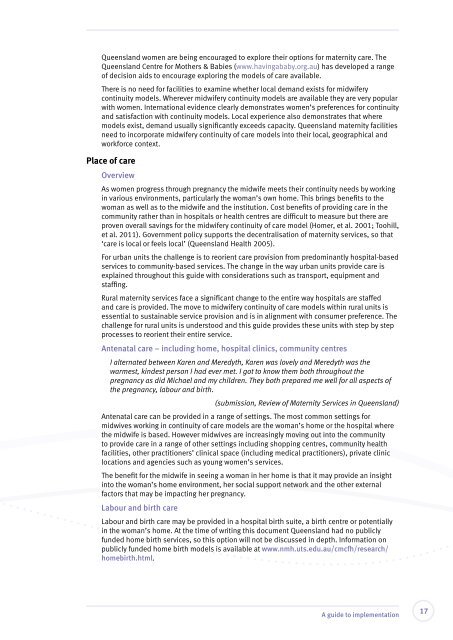Delivering continuity of midwifery care to Queensland women
Delivering continuity of midwifery care to Queensland women
Delivering continuity of midwifery care to Queensland women
You also want an ePaper? Increase the reach of your titles
YUMPU automatically turns print PDFs into web optimized ePapers that Google loves.
<strong>Queensland</strong> <strong>women</strong> are being encouraged <strong>to</strong> explore their options for maternity <strong>care</strong>. The<br />
<strong>Queensland</strong> Centre for Mothers & Babies (www.havingababy.org.au) has developed a range<br />
<strong>of</strong> decision aids <strong>to</strong> encourage exploring the models <strong>of</strong> <strong>care</strong> available.<br />
There is no need for facilities <strong>to</strong> examine whether local demand exists for <strong>midwifery</strong><br />
<strong>continuity</strong> models. Wherever <strong>midwifery</strong> <strong>continuity</strong> models are available they are very popular<br />
with <strong>women</strong>. International evidence clearly demonstrates <strong>women</strong>’s preferences for <strong>continuity</strong><br />
and satisfaction with <strong>continuity</strong> models. Local experience also demonstrates that where<br />
models exist, demand usually significantly exceeds capacity. <strong>Queensland</strong> maternity facilities<br />
need <strong>to</strong> incorporate <strong>midwifery</strong> <strong>continuity</strong> <strong>of</strong> <strong>care</strong> models in<strong>to</strong> their local, geographical and<br />
workforce context.<br />
Place <strong>of</strong> <strong>care</strong><br />
Overview<br />
As <strong>women</strong> progress through pregnancy the midwife meets their <strong>continuity</strong> needs by working<br />
in various environments, particularly the woman’s own home. This brings benefits <strong>to</strong> the<br />
woman as well as <strong>to</strong> the midwife and the institution. Cost benefits <strong>of</strong> providing <strong>care</strong> in the<br />
community rather than in hospitals or health centres are difficult <strong>to</strong> measure but there are<br />
proven overall savings for the <strong>midwifery</strong> <strong>continuity</strong> <strong>of</strong> <strong>care</strong> model (Homer, et al. 2001; Toohill,<br />
et al. 2011). Government policy supports the decentralisation <strong>of</strong> maternity services, so that<br />
‘<strong>care</strong> is local or feels local’ (<strong>Queensland</strong> Health 2005).<br />
For urban units the challenge is <strong>to</strong> reorient <strong>care</strong> provision from predominantly hospital-based<br />
services <strong>to</strong> community-based services. The change in the way urban units provide <strong>care</strong> is<br />
explained throughout this guide with considerations such as transport, equipment and<br />
staffing.<br />
Rural maternity services face a significant change <strong>to</strong> the entire way hospitals are staffed<br />
and <strong>care</strong> is provided. The move <strong>to</strong> <strong>midwifery</strong> <strong>continuity</strong> <strong>of</strong> <strong>care</strong> models within rural units is<br />
essential <strong>to</strong> sustainable service provision and is in alignment with consumer preference. The<br />
challenge for rural units is unders<strong>to</strong>od and this guide provides these units with step by step<br />
processes <strong>to</strong> reorient their entire service.<br />
Antenatal <strong>care</strong> – including home, hospital clinics, community centres<br />
I alternated between Karen and Meredyth, Karen was lovely and Meredyth was the<br />
warmest, kindest person I had ever met. I got <strong>to</strong> know them both throughout the<br />
pregnancy as did Michael and my children. They both prepared me well for all aspects <strong>of</strong><br />
the pregnancy, labour and birth.<br />
(submission, Review <strong>of</strong> Maternity Services in <strong>Queensland</strong>)<br />
Antenatal <strong>care</strong> can be provided in a range <strong>of</strong> settings. The most common settings for<br />
midwives working in <strong>continuity</strong> <strong>of</strong> <strong>care</strong> models are the woman’s home or the hospital where<br />
the midwife is based. However midwives are increasingly moving out in<strong>to</strong> the community<br />
<strong>to</strong> provide <strong>care</strong> in a range <strong>of</strong> other settings including shopping centres, community health<br />
facilities, other practitioners’ clinical space (including medical practitioners), private clinic<br />
locations and agencies such as young <strong>women</strong>’s services.<br />
The benefit for the midwife in seeing a woman in her home is that it may provide an insight<br />
in<strong>to</strong> the woman’s home environment, her social support network and the other external<br />
fac<strong>to</strong>rs that may be impacting her pregnancy.<br />
Labour and birth <strong>care</strong><br />
Labour and birth <strong>care</strong> may be provided in a hospital birth suite, a birth centre or potentially<br />
in the woman’s home. At the time <strong>of</strong> writing this document <strong>Queensland</strong> had no publicly<br />
funded home birth services, so this option will not be discussed in depth. Information on<br />
publicly funded home birth models is available at www.nmh.uts.edu.au/cmcfh/research/<br />
homebirth.html.<br />
A guide <strong>to</strong> implementation<br />
17
















